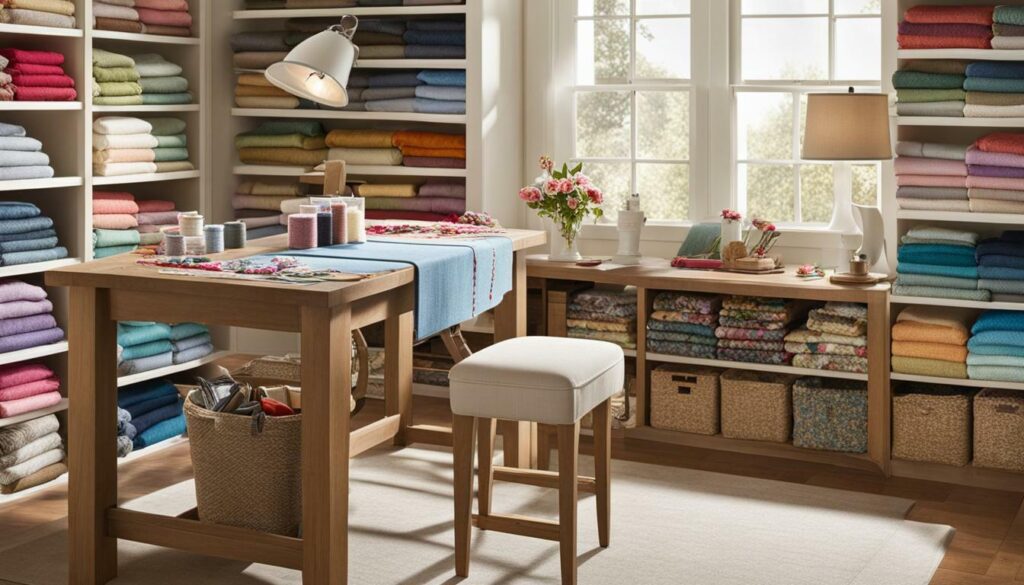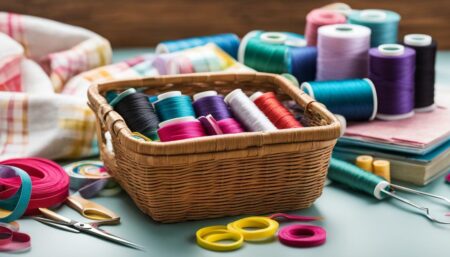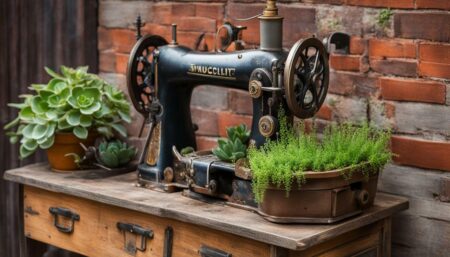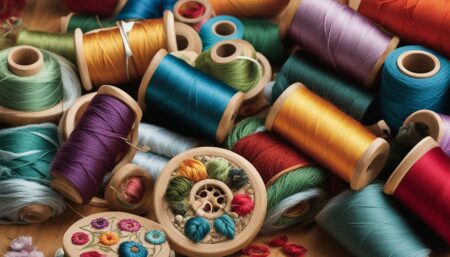Transforming a spare room into a dedicated sewing studio is a dream for many sewing enthusiasts. The ability to work on projects in a space designed specifically for sewing can boost productivity and creativity. However, designing the perfect sewing room can be challenging, mainly if you have limited space. In this section, we will provide practical tips and inspiration for creating a sewing room that is both functional and stylish. From organizing your sewing supplies to selecting the right furniture and equipment, we will explore various sewing studio ideas to help you create a workspace that suits your needs.
- Designing a sewing studio requires careful consideration of space and functionality.
- Organizing your sewing supplies is essential for creating an efficient workspace.
- Selecting the right furniture and equipment can significantly impact your sewing experience.
- Creating a visually appealing sewing room can boost motivation and creativity.
- Incorporating your personality and style into your sewing studio can make it a welcoming and inspiring space.
Designing Your Sewing Room
Designing your sewing room can be fun and exciting, but it’s important to consider the available space and how you want to use it. Get creative with your sewing room setup if you have a small space. Consider using folding tables or a wall-mounted desk to save space when you’re not sewing. You can also use a bookcase or shelves to store your fabrics and supplies.
Small sewing room ideas:
| Tip | Description |
|---|---|
| Use multi-functional furniture | Choose items that can serve multiple purposes, such as a sewing table with built-in storage or a chair that can be used for both sewing and relaxing. |
| Hang tools and supplies on the wall | Use pegboards or hooks to keep your tools and supplies organized and easily accessible. |
| Opt for a neutral color palette | Light colors can make the room feel more spacious and airy, while darker hues can create a cozy and inviting atmosphere. |
When it comes to sewing space decor, choose items that inspire you and make you feel happy. Hang up inspirational posters or artwork related to sewing, and add pops of color with throw pillows or curtains.
Clever Storage Solutions
Storage is key when it comes to organizing your sewing supplies. Consider using a combination of open and closed storage to keep everything within reach. Use clear bins or baskets to store your fabrics and keep them organized by color or project. Use labeled drawers or containers for your threads, bobbins, and other small items.
When choosing furniture, look for pieces that have built-in storage options. A sewing table with drawers or a cutting table with shelves can help keep your space organized and clutter-free.
Optimizing Sewing Studio Layout
The layout of your sewing studio plays a crucial role in your productivity and overall sewing experience. The right sewing studio layout can help you work more efficiently, make it easier to access all your tools and supplies, and improve overall workflow. In this section, we will explore some tips for optimizing your sewing studio layout to create a functional sewing area.
Assess the Available Space
Before you start planning your sewing studio layout, it’s essential to assess the available space. Consider the size and shape of the room, ceiling height, and location of windows and doors. This information will help you determine how much space you have to work with and what types of furniture and equipment will fit into your sewing studio.
Plan Your Workstations
Once you have assessed the space, it’s time to plan your workstations. Determine how many workstations you need and what types of machines you will be using. For example, if you frequently use a sewing machine and serger, you will need a separate workstation for each. If you plan to do a lot of cutting and measuring, you will need a dedicated area for this task as well.
| Workstation | Supplies Needed |
|---|---|
| Sewing Machine | Sewing machine, table, power outlet, lighting |
| Serger | Serger, table, power outlet, lighting |
| Cutting and measuring | Cutting mat, ruler, rotary cutter, scissors, table |
Organize Your Tools and Supplies
Proper organization of your tools and supplies is essential for a functional sewing studio. Consider investing in storage solutions such as cabinets, shelves, and drawers to keep all your sewing essentials in one place. Use labels and dividers to keep everything organized and easy to find.
Create a Flow
Creating a flow in your sewing studio is essential for optimizing your workflow. Arrange your workstations and storage solutions in a way that makes sense and creates a natural flow from one task to the next. For example, you may want to place your cutting and measuring workstation near your fabric storage area.
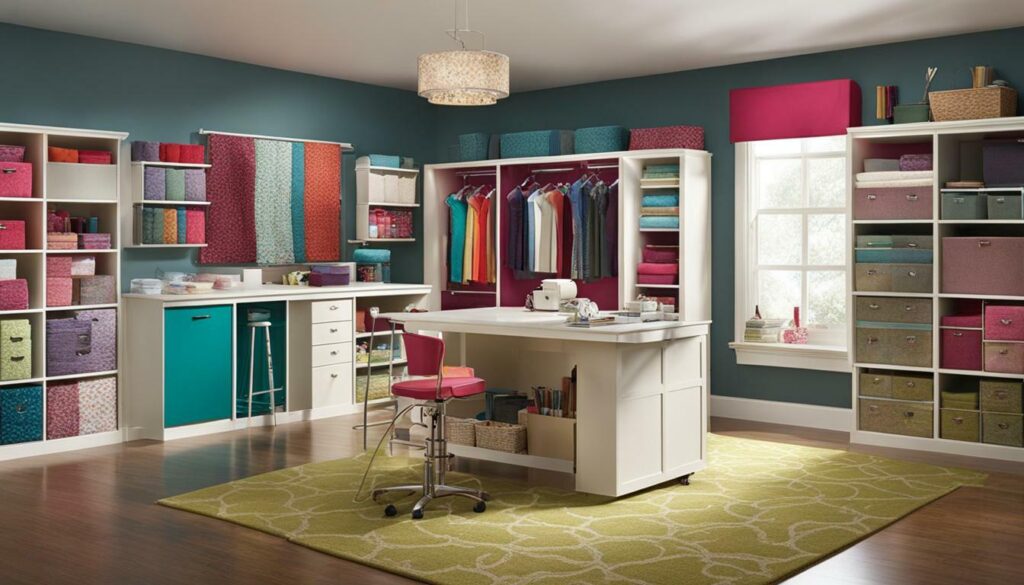
When designing your sewing studio layout, it’s essential to consider ergonomics. Ensure that your workstations and chairs are adjustable and comfortable, and that your machines and tools are positioned at a comfortable height to reduce the risk of strain or injury.
By optimizing your sewing studio layout, you can create a functional sewing area that is organized, efficient, and comfortable. Keep in mind the available space, the number of workstations you need, and the best way to create a flow for your workflow. Also, don’t forget to consider ergonomics to ensure that you are comfortable while working.
Choosing the Right Furniture and Equipment
When designing your sewing room, selecting the right furniture and equipment is crucial for a comfortable and efficient workspace. Consider investing in a sturdy sewing table with ample surface area for your machine and workspace. A comfortable, adjustable chair with good lumbar support is also essential for proper posture and preventing back pain.
When it comes to storage solutions, opt for sleek and functional shelving units or cabinets with ample space for organizing your sewing supplies. Wall-mounted organizers can make use of vertical space while also keeping everything easily accessible.
| Sewing tables: | Chairs: | Storage solutions: |
|---|---|---|
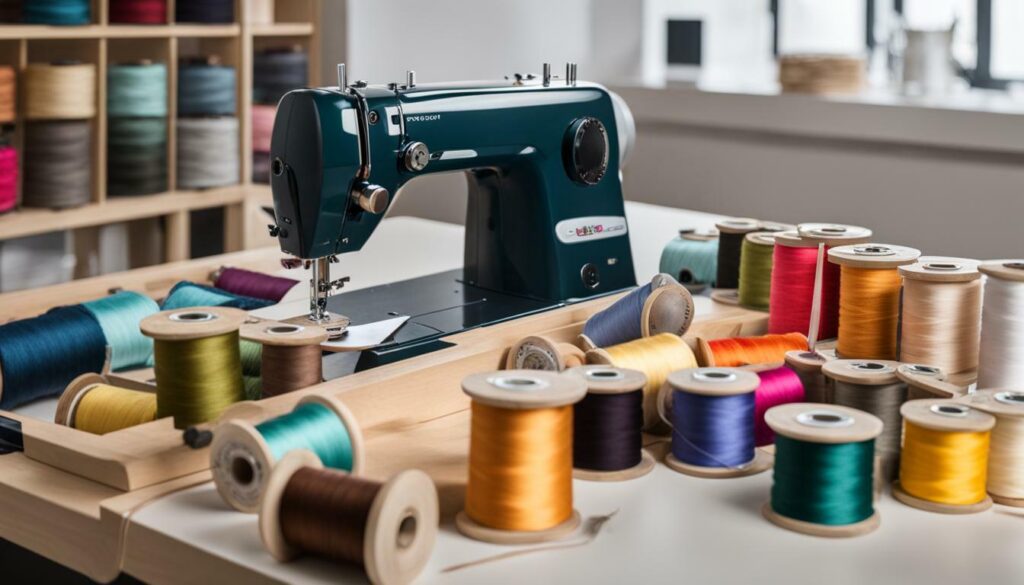
|
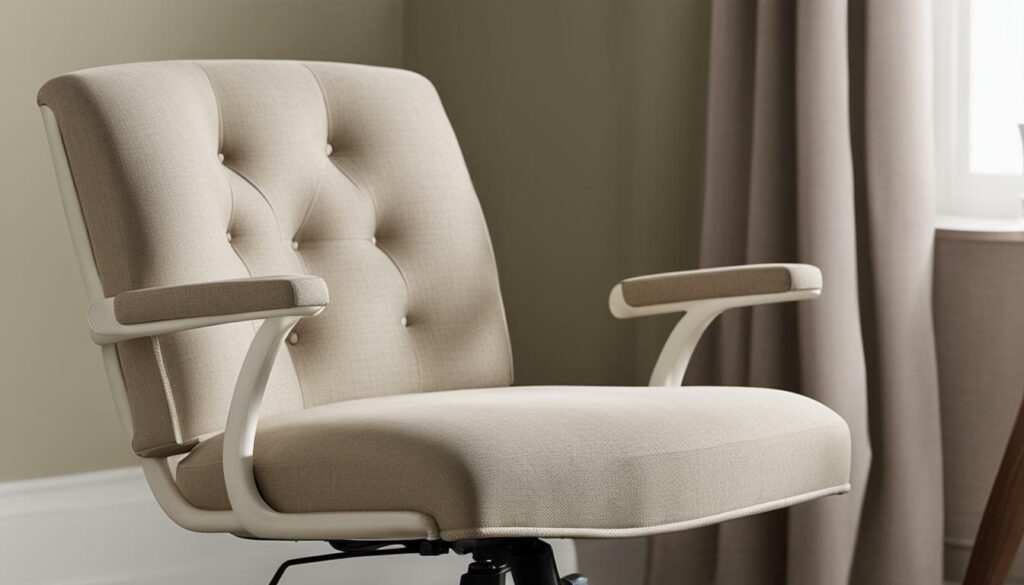
|
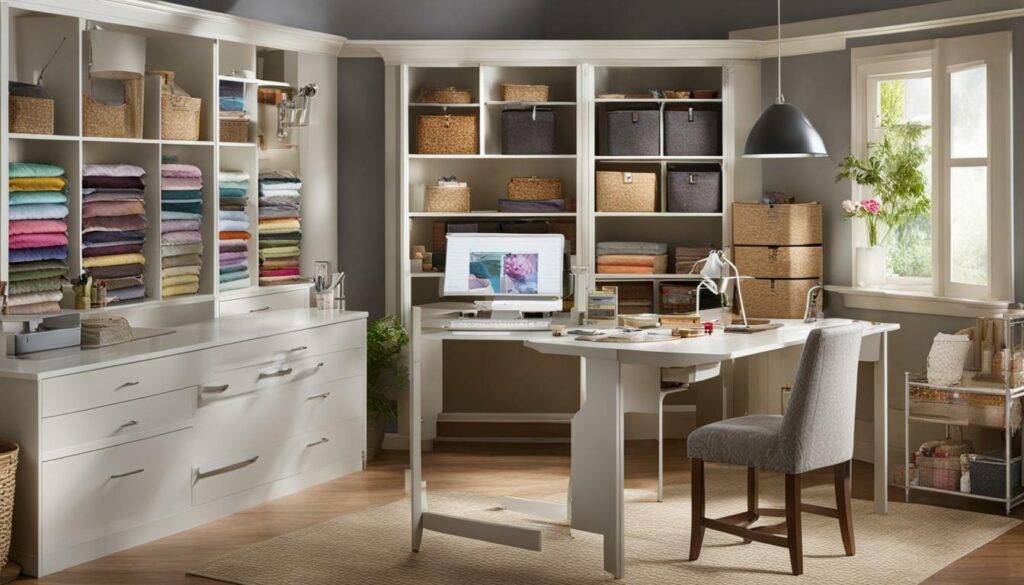
|
Organizing your sewing supplies can be a challenge, but having a designated space for each item can significantly improve your workflow. Consider using clear plastic bins for storing fabric scraps or small supplies like thread and needles. For larger items like fabric, opt for easy-to-reach cubbies or shelves.
Finally, incorporating personal touches like decorative accents and artwork can help make your sewing studio a cozy and inviting space to spend time in. Treat yourself to a comfortable rug, add a vase with fresh flowers, or hang some inspiring wall art to personalize your sewing room.
“Investing in quality furniture and storage solutions can make all the difference, creating a comfortable and efficient workspace that encourages productivity and creativity.”
Creating a Cutting and Measuring Area
In any sewing studio, a dedicated cutting and measuring area is essential for accurate and efficient sewing. You don’t need a large space to create a functional and organized cutting space. Consider installing a cutting table that is at a comfortable height for you to work on. Many sewing tables have a drop-down feature that transforms them into a cutting table. Alternatively, you can make your own cutting table using an old dining table or a countertop.
Keep your cutting tools at arm’s length, such as a rotary cutter, fabric scissors, and a cutting mat. You can also install a pegboard or a wall-mounted organizer to keep your rulers, measuring tapes, and other cutting tools readily accessible.
An overhead light source is essential for accurate cutting and measuring. Ensure that the lighting is bright enough to illuminate your workspace and prevent shadows from interfering with your measurements. You can also consider installing task lighting directly above your cutting table for better illumination.
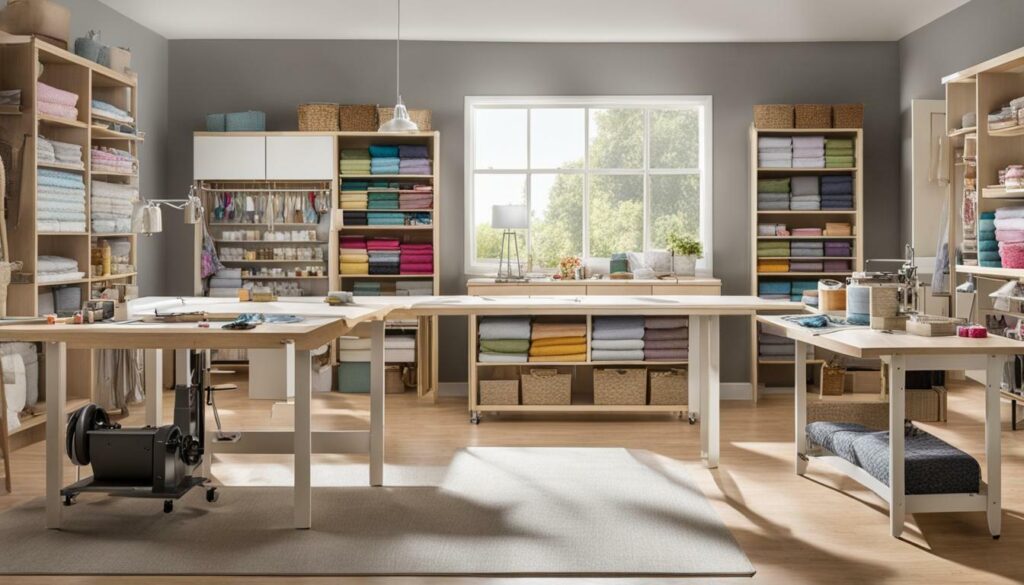
Organizing Your Fabric Collection
A well-organized fabric collection can save you time and frustration while working on sewing projects. Here are some creative ideas and storage solutions for organizing and displaying your fabric in a visually appealing and accessible way:
- Color Code: Sort your fabric collection by color to make it easier to find the right fabric for your projects quickly.
- Clear Storage Bins: Store your fabric in clear storage bins so that you can easily see what you have without having to open each container.
- Shelving: Install open shelving to display your fabric collection, making it easier to see and reach the fabrics you need for your projects. You can also use decorative baskets to store smaller fabric pieces.
- File Folders: Use file folders to organize and store your fabric samples, making them easy to find when you need to match or coordinate fabrics.
- Labeling: Label your fabric storage solutions to help you easily identify and find the fabrics you need.
By organizing your fabric collection, you can not only save time but also create a visually appealing display that can inspire your creativity. The key is to find a storage solution that works best for you and your sewing studio.
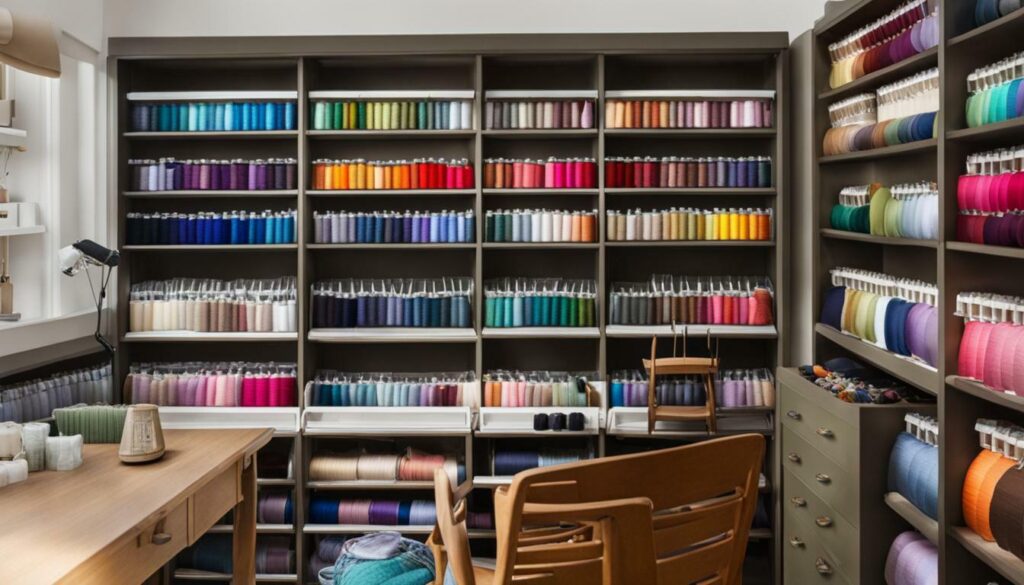
Having an organized sewing studio means having a place for everything, including your sewing notions and tools. The last thing you want is to waste time searching for that elusive pair of scissors or seam ripper. Here are some storage solutions to help you keep your sewing supplies at your fingertips:
1. Bins and Containers
Clear plastic bins and containers are a simple and affordable way to organize your sewing notions. Use them to sort and store items such as buttons, zippers, elastic, and thread. Label each container for easy identification and stack them on shelves or in a closet for efficient use of space.
2. Drawer Dividers
Drawer dividers are an excellent solution for keeping your sewing tools organized. Use them in your sewing machine drawers to separate bobbins, presser feet, and needles. You can also use them in your cutting table drawers for storing rulers, rotary cutters, and scissors.
3. Wall-Mounted Organizers
Wall-mounted organizers are a handy storage solution for frequently used sewing notions. Hang them on the wall above your sewing machine or cutting table for easy access to thread, scissors, and other tools. You can also use them to store patterns and sewing books.
By utilizing these storage solutions, you can keep your sewing notions and tools organized and easily accessible. This will help you save time and avoid frustration while working on your sewing projects.
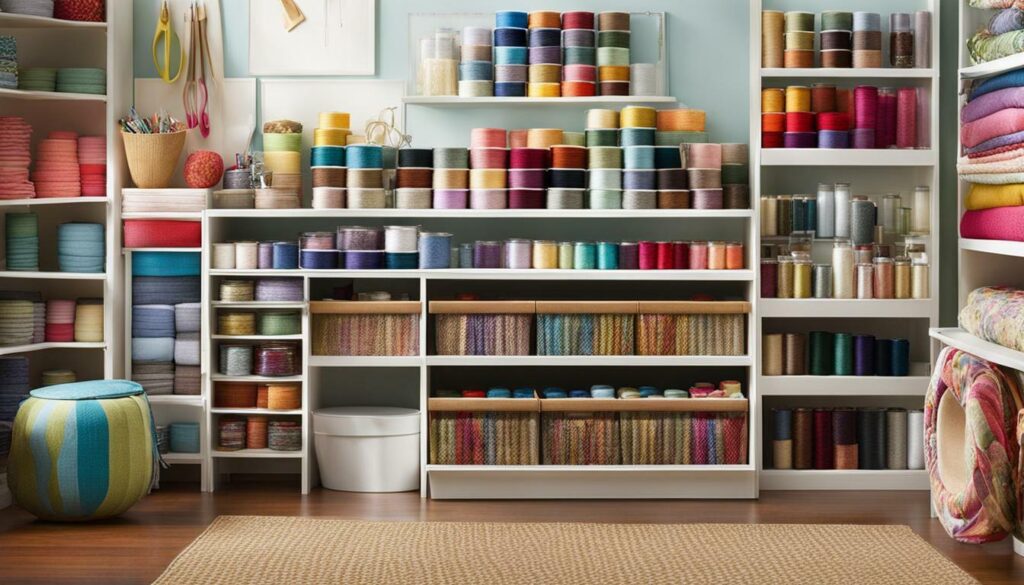
When organizing your sewing space, remember that the goal is to create an efficient and functional workspace. By following the tips and ideas presented in this article, you can create a sewing studio that is both practical and inspiring.
Lighting Tips for Sewing Studios
Adequate lighting is crucial for accurate sewing and preventing eye strain. When designing your sewing room, it’s essential to consider the lighting fixtures and their positioning to create a well-lit and comfortable workspace. Here are a few lighting tips to help you optimize your sewing studio:
- Natural light: Position your sewing machine and workstations near a window to take advantage of natural light. It helps reduce eye strain and provides a more comfortable working environment.
- Overhead lighting: Consider installing overhead lighting fixtures that provide bright and even illumination for your entire sewing area. Pendant lights or track lighting systems can offer flexibility in terms of positioning and aiming the light.
- Task lighting: For more precise sewing tasks such as embroidery, quilting, or small stitching, task lighting is essential. Floor lamps or desk lamps with adjustable arms and shades can provide more targeted lighting in a specific area.
By combining different lighting sources, you can create a well-lit and functional sewing studio that meets your unique needs. Test out different lighting options and positions to find the perfect setup for your sewing space.
Creative Ideas for Personalizing Your Sewing Studio
Personalizing your sewing studio is an excellent way to infuse your personality and creativity into your workspace. Whether it’s adding some color, displaying your finished projects, or featuring inspirational quotes, there are many ways to make your sewing studio feel like your own.
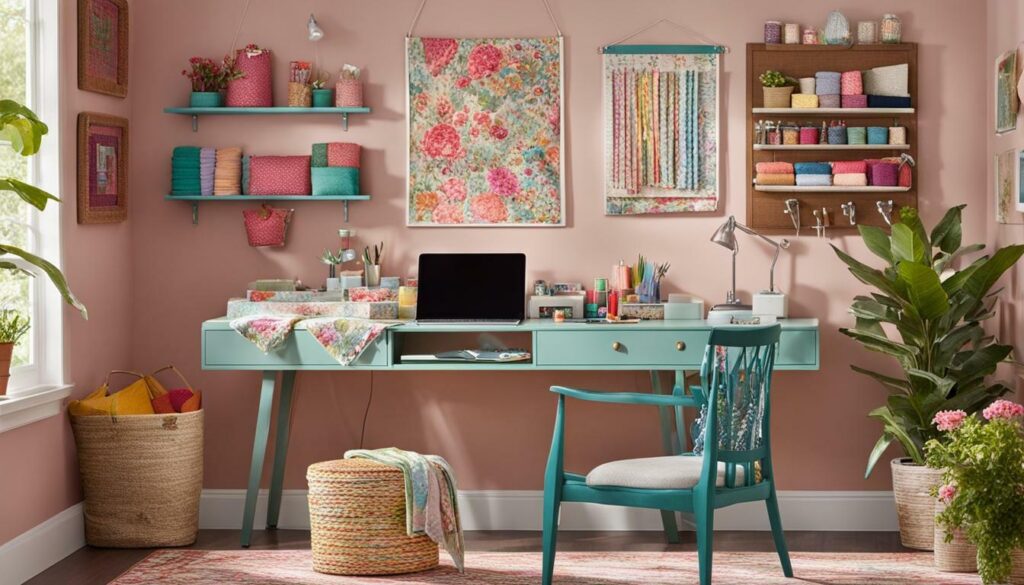
One option for adding a personal touch is by incorporating your favorite colors. You can paint the walls in a shade that inspires you or add pops of color through curtains, rugs, or cushions. You can also display your finished projects, such as quilts or dresses, as artwork on your walls.
Inspirational quotes are another popular option for decorating sewing studios. You can print and frame your favorite quotes or sayings that motivate and inspire you. Adding plants or flowers can also create a refreshing and calming atmosphere in your sewing studio.
If you’re feeling crafty, consider creating some DIY decor for your sewing studio. You can upcycle old fabric scraps into bunting or build a wall hanging with your favorite sewing notions. Another great DIY idea is to re-purpose vintage sewing machine drawers into storage solutions for your sewing supplies.
Incorporating personal touches into your sewing studio can make it a space that inspires you and reflects your unique style. With these creative sewing studio decor ideas, you can transform your workspace into a stylish and inviting place to sew.
Incorporating Ergonomics in Your Sewing Studio
As you spend extended periods working on your sewing projects, it’s crucial to consider ergonomics in setting up your sewing area. Ergonomics refers to the science of designing a space, equipment, and tools to enhance productivity, comfort, and safety. Here are some tips for incorporating ergonomics in your sewing studio:
- Adjust your sewing machine: Ensure your sewing machine sits at a comfortable height that minimizes strain on your back and neck. Adjust the foot pedal to a comfortable position that does not require your feet to stretch or strain when sewing.
- Optimize your chair: Use a chair that provides adequate back support, adjustable height, and a comfortable sitting area. Choose a chair with wheels that enables you to move around your sewing studio with ease.
- Position your work surface: Ensure your work surface sits at a comfortable height that allows you to work in a relaxed posture. Avoid hunching over your work surface, which can cause neck and back strain.
- Take frequent breaks: Take frequent breaks to rest your eyes, stretch your body and move around. Sitting for prolonged periods may affect blood circulation and cause stiffness and discomfort.
By incorporating ergonomics in your sewing studio, you can minimize the risk of injury, enhance your productivity, and ensure comfort while working on your sewing projects.
Now that you’ve created a functional sewing space, it’s important to maintain its organization and cleanliness. Regularly tidying up your sewing room and keeping your supplies organized will help you stay productive and focused. Here are some tips for maintaining a well-organized sewing studio:
- Put things away after each use: After every sewing session, take a few minutes to put away your fabrics, threads, and tools. This will prevent clutter from building up and make it easier to find what you need when you start your next project.
- Regularly review your supplies: Go through your fabric, patterns, and notions every few months to see what you no longer need. Consider donating or selling items that you haven’t used in a while to make more room in your sewing studio.
- Label everything: Invest in a label maker and use it to label bins, drawers, and boxes in your sewing room. This will make it easy to find what you’re looking for and prevent mix-ups.
- Keep a clean workspace: Wipe down your sewing machine, cutting table, and other work surfaces regularly to keep them free of dust and debris. A clean work area will help you focus and prevent fabric from getting dirty.
- Take inventory: Make a list of your sewing supplies and keep track of what you have on hand. This will prevent you from buying duplicates and help you restock when needed.
By following these tips for sewing space organization and organizing sewing supplies, you can ensure that your sewing studio remains a clean, efficient, and productive workspace.
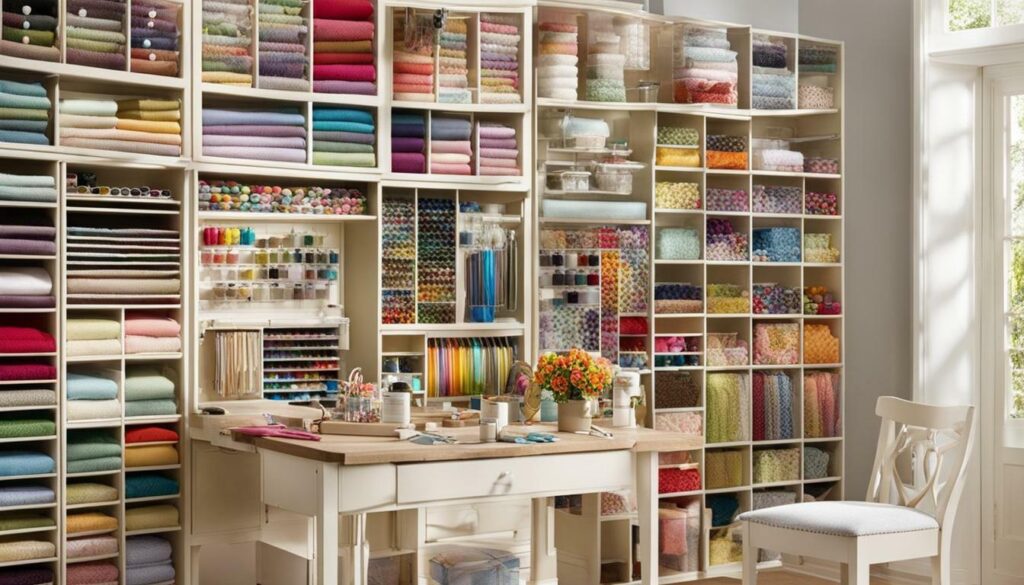
With these creative and functional sewing studio ideas, you can transform any spare room into a stylish and efficient workspace for all your stitching projects. By considering the design, layout, organization, and personalization of your sewing studio, you can create a space that inspires creativity, boosts productivity, and enhances your sewing experience.
Remember, designing a great sewing studio that meets your unique needs is a process that takes time and effort. If you’re feeling overwhelmed, take it one step at a time, refer to our guide for inspiration, and don’t be afraid to experiment and try out different ideas until you find what works best for you.
We hope this article has been helpful in providing you with the information needed to create a sewing studio that you’ll love spending time in. Happy stitching!
FAQ
What are some small sewing room ideas for maximizing space?
Some small sewing room ideas include utilizing wall space for storage, using multipurpose furniture, and incorporating foldable or collapsible work surfaces.
How can I create a visually appealing sewing space?
You can create a visually appealing sewing space by incorporating a cohesive color scheme, adding decorative elements like artwork or plants, and keeping your workspace clean and organized.
What are some tips for optimizing the layout of a sewing studio?
To optimize the layout of your sewing studio, consider the flow of your work process, designate specific areas for cutting, sewing, and pressing, and ensure that your tools and equipment are easily accessible.
What should I consider when choosing furniture and equipment for my sewing room?
When choosing furniture and equipment for your sewing room, consider the size of your space, the functionality you require, and the quality and durability of the items. Additionally, think about storage options for organizing your sewing supplies.
How can I create a functional cutting and measuring area in my sewing studio?
You can create a functional cutting and measuring area by designating a specific space for these tasks, ensuring you have a large enough surface for cutting fabric, and organizing your tools, rulers, and measuring tapes for easy access.
What are some creative storage solutions for organizing sewing notions and tools?
Some creative storage solutions for organizing sewing notions and tools include using clear plastic bins or drawers, utilizing magnetic strips or containers for holding small metal objects and repurposing everyday items like mason jars or spice racks for storage.
How can I optimize lighting in my sewing studio?
To optimize lighting in your sewing studio, consider natural lighting sources like windows or skylights, supplement with overhead or task lighting fixtures with adjustable brightness, and position your lighting sources to minimize shadows on your work area.
How can I personalize my sewing studio?
You can personalize your sewing studio by adding decorative elements like inspirational posters or artwork, incorporating your favorite colors or patterns, and displaying sentimental or handmade items that inspire you.
What is the importance of ergonomics in a sewing studio?
Ergonomics is essential in a sewing studio to ensure your workspace is comfortable and promotes good posture and body mechanics. Proper ergonomics can help reduce the risk of strain, fatigue, and injury during long sewing sessions.
How can I maintain the organization of my sewing studio?
You can maintain the organization of your sewing studio by regularly decluttering and organizing your supplies, implementing storage systems or containers for specific items, and developing a cleaning routine to keep your workspace tidy.



